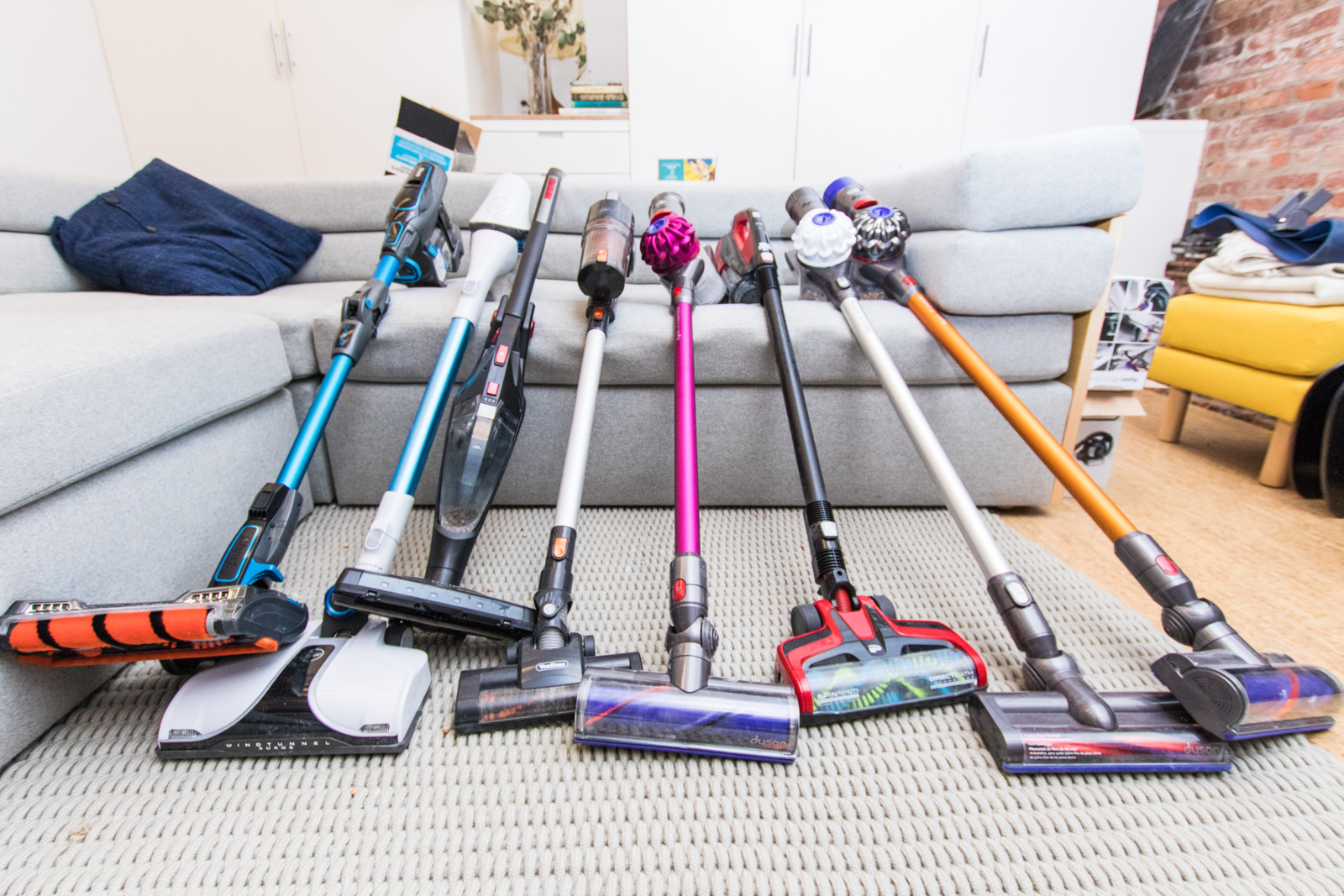 By Liam McCabe and Michelle Ma This post was done in partnership with Wirecutter. When readers choose to buy Wirecutter's independently chosen editorial picks, it may earn affiliate commissions that support its work. Read the full article here. Power cords got you wound up? If you want a cordless vacuum that can clean your entire home, the Dyson V7 Motorhead is probably your best bet. It's as powerful as cordless vacuums get, with the best handling, quietest operation, and easiest to empty dustbin for the price. We've done more than 125 hours of research and testing on cordless vacuums over the past three years, and this was an easy choice to make. We found in our testing that the V7 Motorhead is particularly good at getting dust and hair out of carpets, compared with most other cordless models. It works well on bare floors, too. The battery can last 28 minutes with the cleaning head attached, which is plenty for most apartments or townhouses, and even a lot of single-family houses if you work fast. It can also convert into a handheld vacuum, and comes with two snap-on tools. On the downside, the V7 is a very expensive vacuum. But if you want a cordless vacuum that can clean your whole home as thoroughly as a good plug-in model, this is how much it costs. Our runner-up is the only model that comes close to matching the cleaning performance, but we think paying the extra amount for the V7 is worth doing because this model is easier to use. The Shark IonFlex DuoClean Cordless Ultra-Light isn't our main pick because it's noticeably heavier and louder than the Dyson V7 Motorhead. It's not quite as strong of a carpet cleaner, either, and the battery lasts for only 20 minutes. But it's better at cleaning upholstery and picking up big crumbs off bare floors, and has a longer warranty. The battery pack is also removable and charges in a separate dock, which could help the IonFlex DuoClean have a longer life span than the V7. If those upsides seem more important to you, grab this Shark instead of the Dyson. The Dirt Devil Reach Max Multi Cordless Stick (BD22522) is a more affordable vacuum that works fine for tidying a small space. Like other cordless vacuums at this price, it's not powerful enough to suck all the dust out of your carpets, and it's not great with stuck-on pet hair. But for surface-level crumbs, our tests showed it does the job better than other budget-friendly models. It also has a respectable 20-minute battery life and several useful accessories, and it's lighter than our other picks. The Dyson V8 Absolute is the best cordless vacuum overall. It's essentially the same vacuum as the V7, with a little more suction, six minutes of extra battery life, and some tools that help it clean upholstery and bare floors better—useful but mostly marginal advantages over our main pick, for a whole lot more money. It is a great machine, though the price is way steep. Why you should trust us Liam McCabe, who wrote the first few versions of this guide, has covered vacuums for Wirecutter for more than four years, logging hundreds of hours of vacuum research and testing. He's personally tested dozens of vacuums of all types (cordless, robots, handhelds, and traditional plug-ins) in several homes with varied floor plans. And he has at least passing knowledge of hundreds more vacuums. He wrote this guide from 2014 through 2016 (at one point, he had more than 19 vacuums in his condo for testing), and has edited it since 2017. And for what it's worth, he's mostly lived in spaces where cordless vacuums are easier to use than plug-ins. Michelle Ma is a former retail reporter who has interviewed dozens of manufacturers about how their products are made, sold, and used. For this update, she looked into 32 new models and logged over 20 hours testing nine models total, both at home and at our test site. She also lives in an apartment with a tight floor plan, where a cordless vacuum makes more sense than a plug-in model. Although we do our own testing, we also think it's important to hear what other people have to say. We've interviewed a bunch of vacuum experts over the years, including: - Kyle Wiens, CEO of iFixit, which publishes vacuum repair manuals
- Caroline Blazovsky, founder of My Healthy Home and indoor air quality specialist who sits on the Indoor Air Quality Association's public education committee
- Greg Truex, senior director at J.D. Power who handles home appliance studies
- David VanAmburg, managing director at the American Customer Satisfaction Index
- Justin Haver, vice president at GoVacuum.com and 20-year veteran of the vacuum industry
- Denis Spindler, owner of Mr. Sweeper Sew & Vac in Waltham, Massachusetts, since 1984 (and an employee there since 1977)
- Brian Driscoll, a vacuum service technician and shop manager known as the Vacuum King of Reddit from his series of popular AMAs
- Jeffrey May, indoor air-quality consultant and author of My House Is Killing Me!: The Home Guide for Families with Allergies and Asthma
- Brian Oliver, brand manager (at the time) of the Asthma and Allergy Foundation of America
- Rob Green, reliability manager (at the time) at Dyson
- Anthony Del Gaudio, a product manager (at the time) for Miele
- Josh Mutlow, senior design engineer at Dyson
- Christopher Shook, director of engineering at Stanley Black & Decker
- Zara Jones, product manager of handheld vacuums at Stanley Black & Decker
- Keith Barry, editor in chief of Reviewed Home
- Rich Brown, executive editor of appliance reviews at CNET
We've also made a point to listen to as many of our readers as we can through comments on our guides, emails, Twitter exchanges, and message board posts. And we also read other vacuum reviews, including customer reviews (we've easily scanned more than 1,000) as well as those from other editorial sources like CNET, Consumer Reports, Good Housekeeping, and Reviewed.com. Who should get this 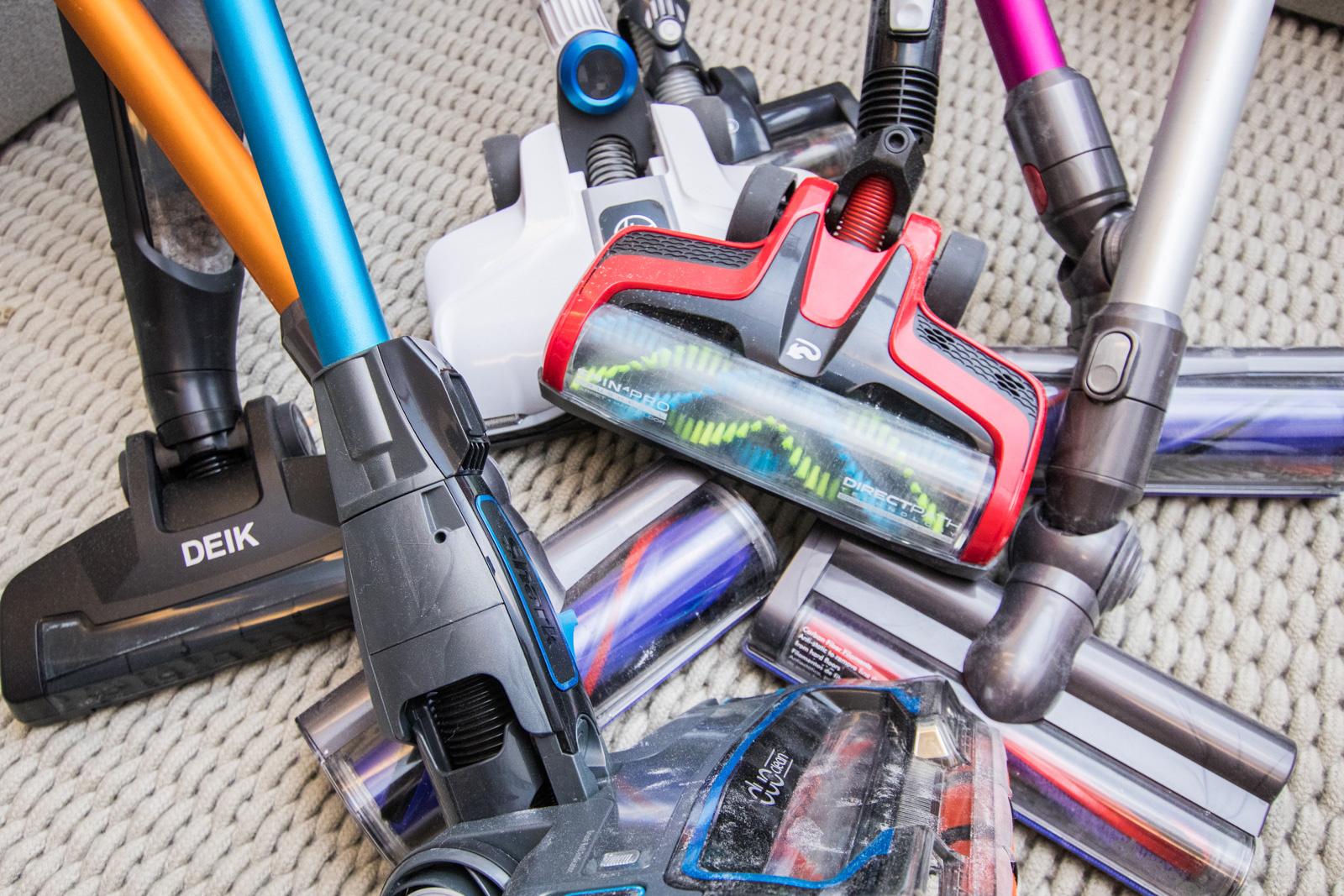
Photo: Michael Hession If you're willing to pay more for the convenience of a cordless vacuum, go for it. The best cordless vacuums now have enough cleaning power to match good plug-in vacuums, and enough battery life to clean small to midsize homes in a single session (up to roughly 2,000 square feet for our main pick). Obviously, the best part about owning a cordless vacuum is that you have no cable to unwrap and rewrap during every cleaning session or to catch on corners and doorways. If you've ever skipped vacuuming because you're feeling too lazy to unwrap the cord (guilty as charged) or your cramped floor plan makes cord-wrangling feel like a major chore, a cordless vacuum can be a life-changer. They're also typically thin and light, which makes them easy to handle and to stash away between uses. Apartment dwellers usually gain the most by going cordless. But cordless vacuums have some disadvantages compared with good plug-in models. They always cost much more than models with comparable cleaning ability. For example, our main pick costs more than twice as much as our favorite plug-in model. Cordless vacuums also have much shorter life spans on average, as well as shorter warranty periods most of the time. That's partly because the batteries in cordless vacs are likely to wear out after a few years. Their batteries don't last long enough to clean big houses. Even the longest-lasting models won't quite be able to clean a typical new-construction house (about 2,600 square feet) in a single session. They also all need at least three hours to recharge, so once the battery dies, you'll need to walk away from cleaning for a while. And compared with the very-best plug-in models, cordless vacuums can't clean as deeply or filter dust as effectively. If you need more help choosing the right type of vacuum for your home, start with our guide to the best vacuums. How we picked 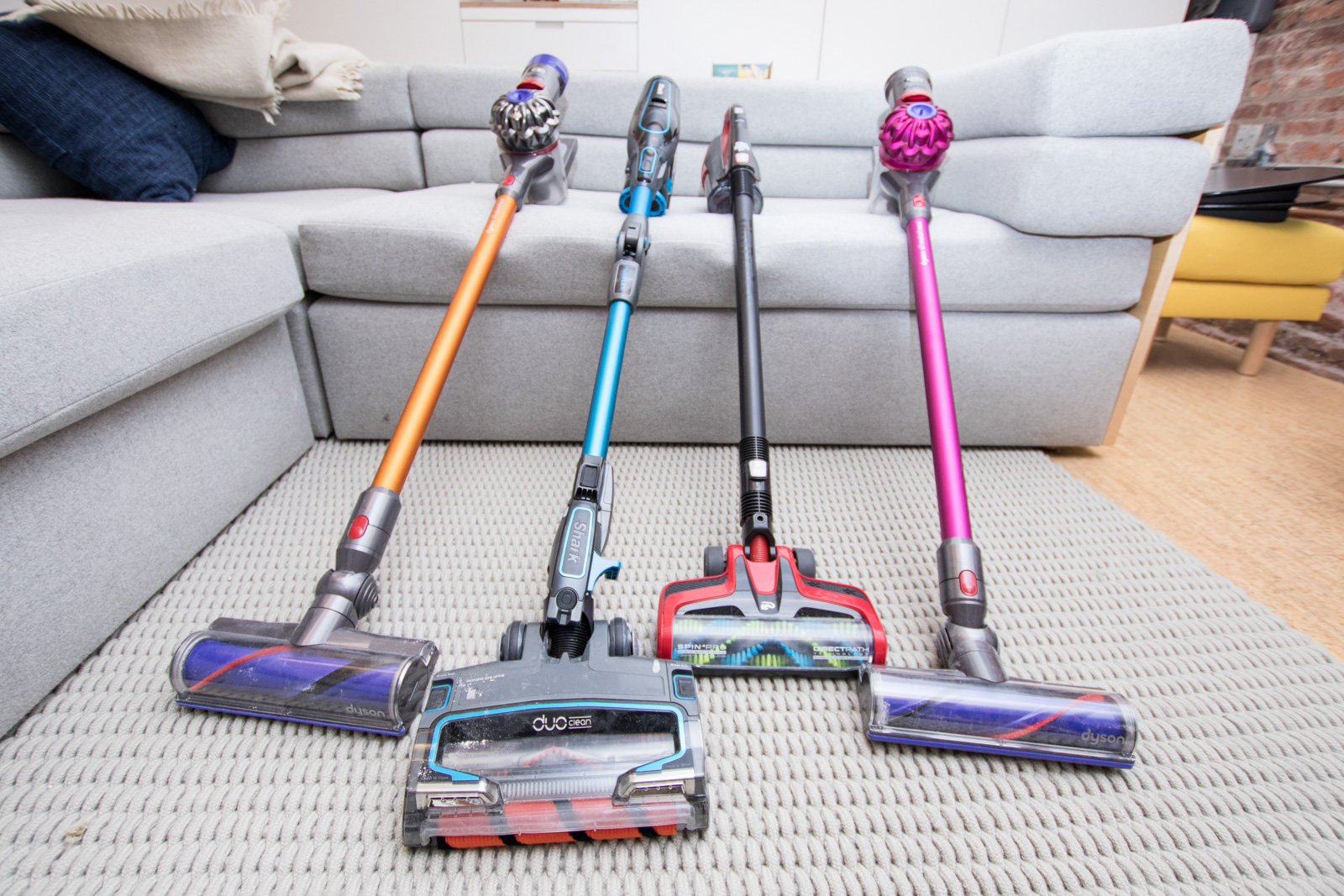
Our picks (left to right): Dyson V8 Absolute, our upgrade pick; Shark IonFlex DuoClean, our runner-up; Dirt Devil Reach Max Multi, our budget pick; Dyson V7 Motorhead, our main pick. Photo: Michael Hession We started by making a list of all the cordless vacuums we could find. Since 2014, when we began to cover this category, we've tracked 115 models (though many are now discontinued). Here are the factors we prioritized: Crucial, bare-minimum features: We didn't seriously consider any models that didn't meet these baselines. - A 20-volt battery or greater: More voltage does not necessarily mean more cleaning power, but 20 volts is a good baseline for decent suction. Weaker batteries struggle with larger debris, like the road salt or chunks of food we sometimes cleaned up while testing.
- A lithium or lithium-ion battery: Most cordless vacuums now use this battery type, but some old stragglers out there still use NiCD or NiMH batteries. Those types take much longer to recharge than lithium-based cells, and NiCD-based models are particularly awful because they start to lose suction about halfway through their running time.
- At least 20 minutes of running time: That's about the cutoff for 1,000 square feet of cleaning. Because we were looking for a cordless vacuum that could replace a plug-in, we wanted to find something that could work in more types of homes than just small apartments, even if it couldn't quite handle the average American house.
- Can convert to a handheld vacuum: Most of the time you'll be cleaning your floors, but it's handy to have a two-in-one design so that you can clean windowsills, shelves, curtains, ceilings, upholstery, and tight spaces around furniture and appliances.
- Bristled brush roll: This is crucial if you want your vacuum to really work on carpets.
Important, useful features: These traits set the best models apart from the good ones. - Cleaning power: Some cordless vacuums are much better than others at getting ground-in hair and dust out of carpets and cracks between floorboards. Although battery voltage and a good brush roll can tell you a little bit about this, the best way to get at this is through testing. A good cordless vac should suck up noticeable debris from bare floors and short- or medium-pile carpets in a couple of passes, as well as some of the less-noticeable fine dust and hair that accumulates deeper in carpets over time.
- Comfort and handling: People with wrist pain, or who live in tight spaces, often turn to a cordless vacuum for the ease of handling it provides over a traditional upright. So we looked for models that didn't feel heavy and clunky and that could steer around corners and into tight spaces with ease. A swiveling joint really helped with handling, though most models have one these days. An easy-to-empty dustbin, intuitive controls, and easy-to-remove filters also factored into our decisions.
- More battery life: Although 20 minutes was our baseline, the more the merrier.
- Noise: The typical upright vacuum comes in at around 70 decibels (dBC), so we're looking for something around that or lower. Aside from general loudness, we also looked for vacs that operated at lower frequencies, which sound less annoying.
- Strong customer ratings: We've found that an average customer rating of four out of five stars is an accurate cutoff for user satisfaction. Any lower is a sign of a design flaw or quality-control problem.
Less-important features: These are factors that may seem important, but are actually so similar from model to model that they're not worth fussing over. - Warranty: Warranties are typically around two years for most cordless vacuums, though we did favor brands with better reputations for responsive customer service. We also heard from the folks at J.D. Power that only 5.8 percent of people actually use their warranties, so it's low on the list of priorities for most people.
- Reusable filters and swiveling joints: Both are pretty much a given on any cordless vacuum these days.
We found that the sweet spot for cordless vacuums with all the right specs (on paper at least) can be anywhere from $180 to $350. Cheaper vacuums under $180 lack some important features and won't come close to replacing a good plug-in vacuum. However, some work fine to tidy smaller spaces—not a bad choice for a cozy apartment with light or no carpeting, or as a secondary vacuum for your kitchen. Spend less than $80, and they're all bad. Spending more than $350 can yield some marginal upsides, like a somewhat longer battery life, or extra attachments that improve cleaning performance in some scenarios. You can get one of these if you want, though it's a lot of money to pay for modest improvements. After winnowing the possibilities based on specs, we decided to call in nine vacuums for testing: For previous versions of this guide, we also tested the Hoover Linx, Hoover Air Cordless Lift, Hoover Cruise, Black+Decker Smartech HSVJ520JMBF27, and Eufy HomeVac Lightweight, which are all still available. We didn't think that they were the best picks last year, so we didn't retest them this year. How we tested 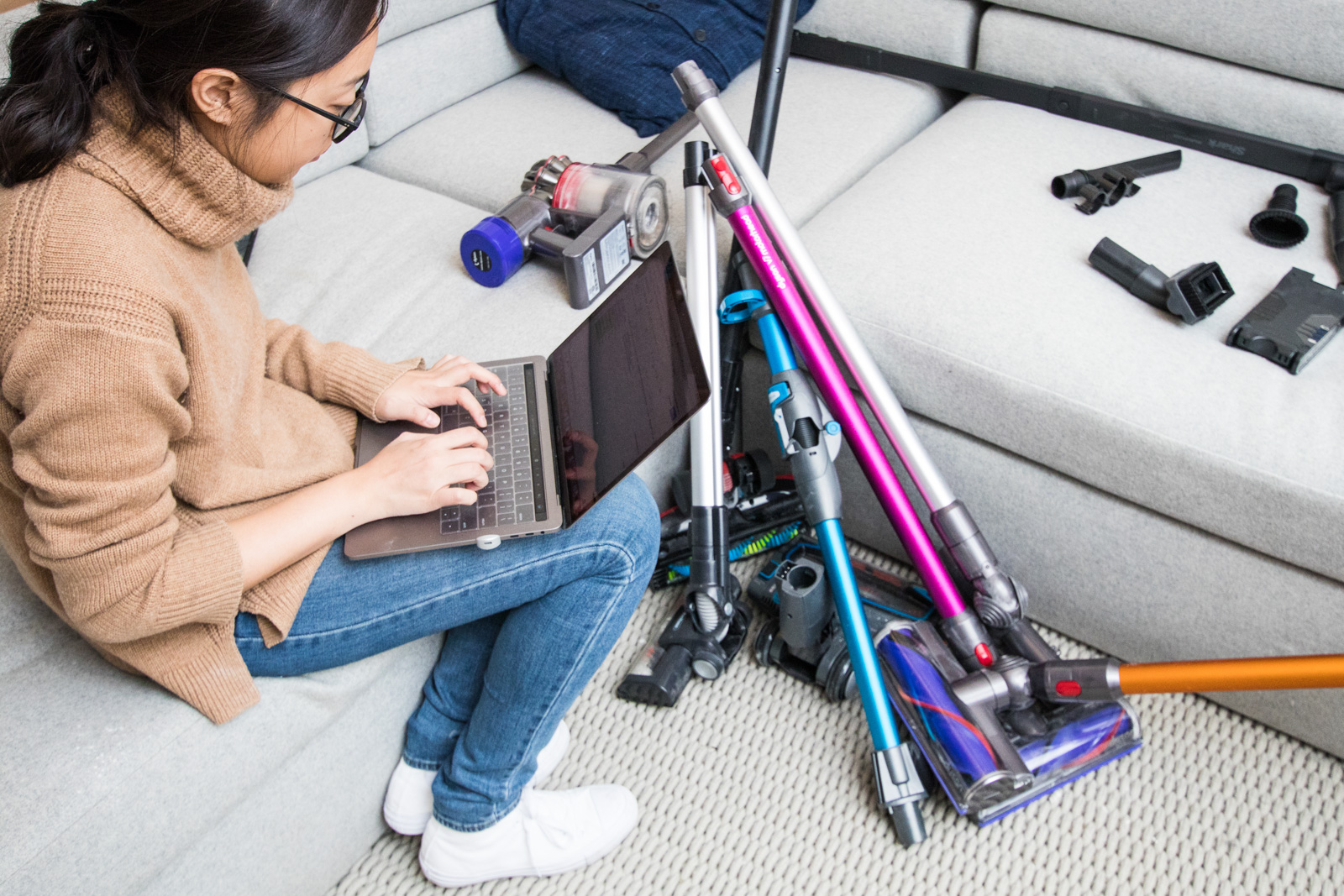
We tested our finalists at home, as well as at our office. Photo: Michael Hession We tested at home and at our test center, measuring cleaning performance, handling, battery life, noise, and ease of maintenance. 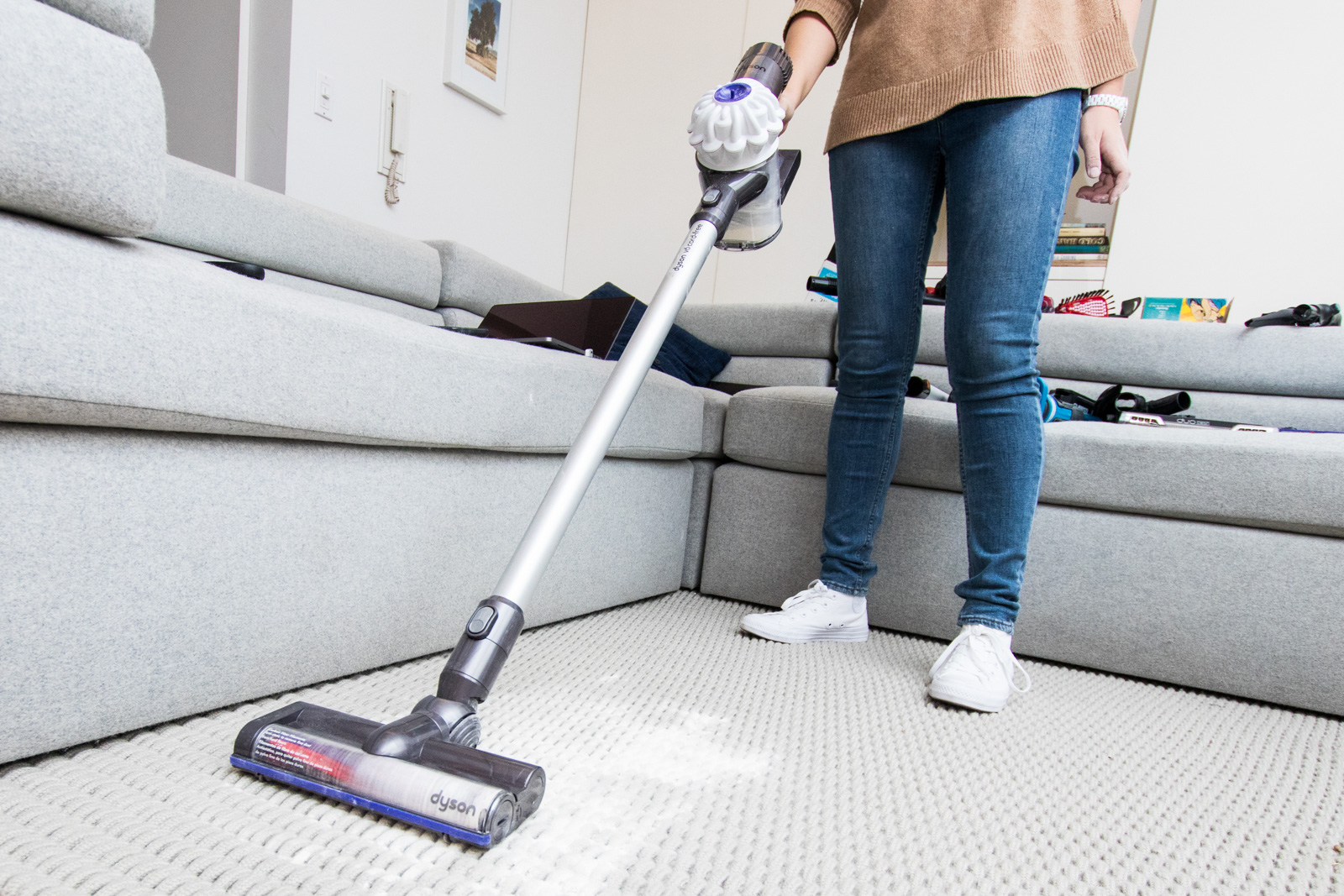
Our flour-pickup test separated the best vacuums from the ones that were just okay. Photo: Michael Hession The most important feature of a vacuum is obviously suction strength. To test for that, we sprinkled half a cup of flour over a patch of a knitted, low-pile rug and gave each vacuum three minutes to suck out as much flour as it could. We then used a kitchen scale to measure how much flour was picked up in the dustbin. (To keep things standardized, we cleaned the rug with a powerful Miele plug-in model between each test). 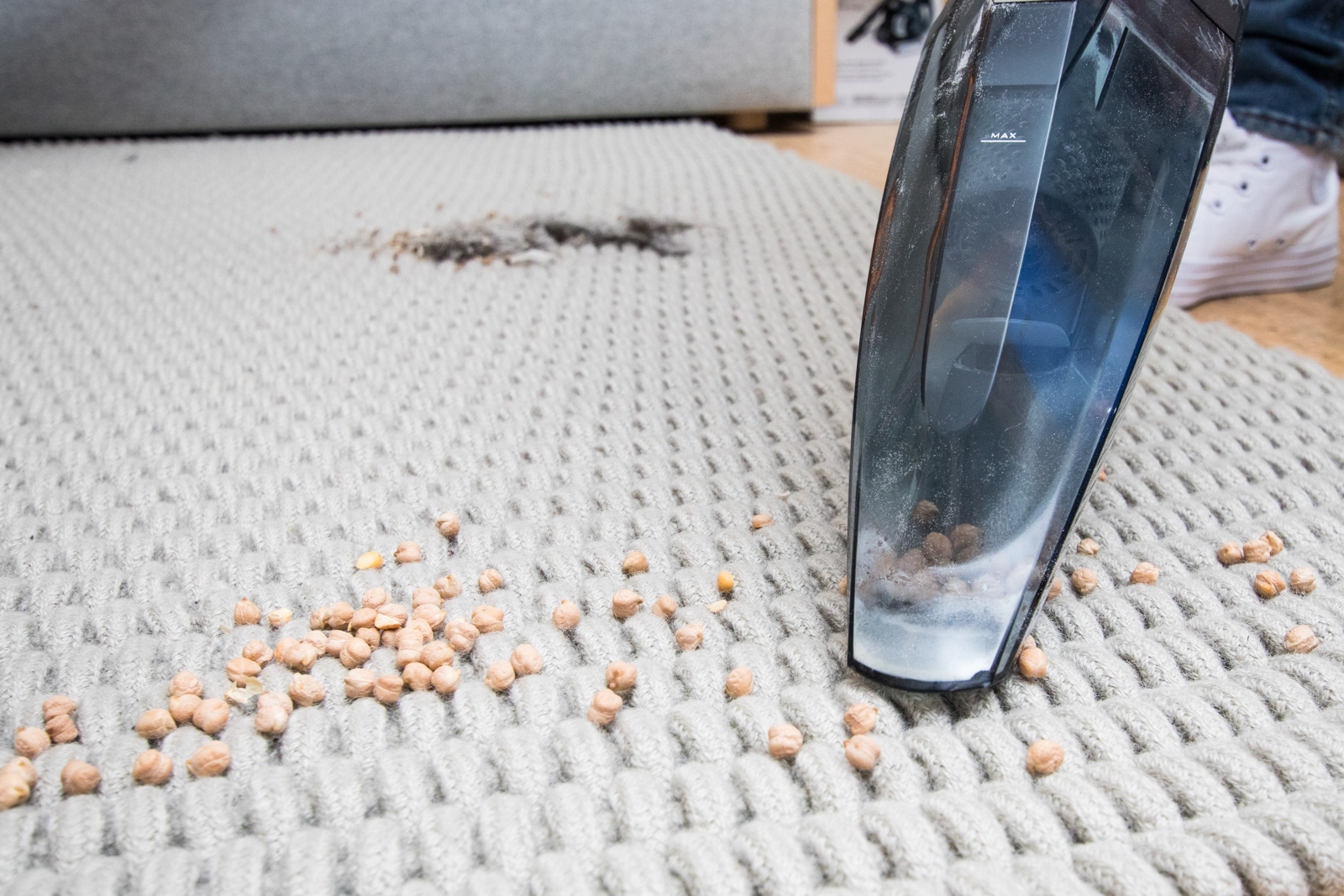
We tested large-particle pickup too, with the floor-cleaning heads as well as in handheld mode. Photo: Michael Hession One of the biggest complaints we hear about vacuums is that they can't handle pet hair, which is notorious for burrowing its way into upholstery and not letting go. To compare how these vacs do against our furry friends, we rubbed the hair of a Maine Coon cat into the cushion of a velvet couch. We then attached the most suitable brush head onto the handheld portion of vacuum, set it to the highest suction mode, and timed how long it took each of our contenders to pick up all the hair. 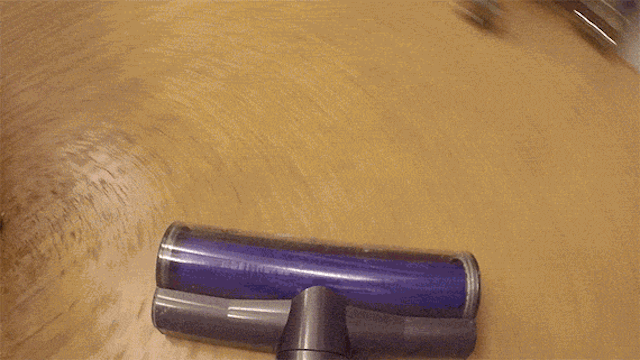
We ran each vacuum through a standardized slalom course. And yes, we stuck a GoPro to one of them to make this GIF. Video: Michael Hession For handling, we ran each model through a timed slalom course, simulating a real-life apartment with a tight floor layout. Racing a vacuum through an obstacle course isn't exactly how you would use one of these, naturally, but it clued us in on a few frustrations and flaws that might annoy owners, like how vacuums can bunch up area rugs or struggle to get around corners. Most cordless vacuums have about as much battery life as their manufacturers say they do, we've found. But we double-checked using a stopwatch anyway, because sometimes the vacuums meet their advertised run time only under certain conditions, like with the brush roller turned off, or with certain tools attached. To measure noise levels, we used the SPLnFFT app on an iPhone 6 with an external microphone attached to a smartphone to test for noise levels. This app measures both volume (in decibels) and frequency (in hertz). To test for ease of maintenance, we tried to clog and tangle each machine with tough debris like shredded copy paper, balls of cat hair, sawdust, and socks. And if we succeeded in jamming them up, we figured out how to unclog them. The fewer tools and the less time needed, the better. Our pick: Dyson V7 Motorhead 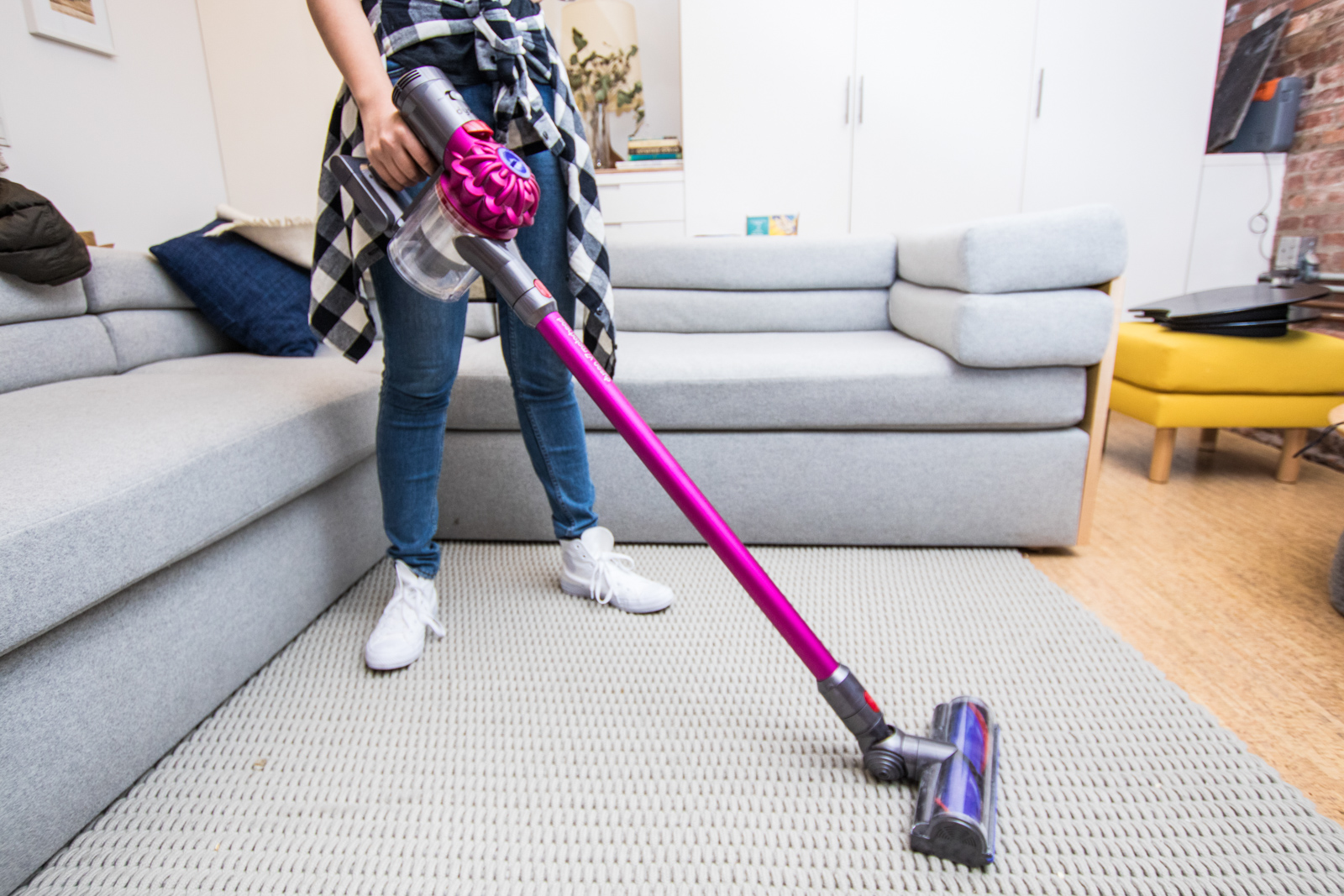
Photo: Michael Hession The Dyson V7 Motorhead is the best cordless vacuum for most people because it's as strong as they come, and is the quietest, smoothest, overall most-pleasant to use. In our testing, it proved to be the most thorough carpet cleaner and also worked well on bare floors. We also found that it was the quietest model for the price, with smooth handling and the easiest to empty dustbin. It converts into a handheld vacuum as well. The 28-minute run time is enough to clean up to 2,000 square feet in a single session, we'd estimate. That's more than enough for most apartments and townhouses, and some single-family houses, too. Although models like the Shark IonFlex DuoClean and the Dyson V6 clean about as well as the V7, they're also louder and harder to empty, with shorter battery life. If you just want a cordless vacuum for quick cleanups, this is overkill. But if you want one to take the place of a bulky plug-in, the V7 can do the job in most homes. The V7 is as powerful of a cleaner as almost any cordless vacuum. A few models match or nearly match its cleaning performance, but nothing (except the Dyson V8 flagship model) beats it. In our crumb-cleanup tests, the V7 usually picked up the majority of debris from a plush rug in one back-and-forth pass, which no other cordless vac managed. In powder-cleanup tests, it consistently picked up most fine debris from bare floors (including cracks between the boards) in one pass. It sucked up the most flour from a rug in a three-minute period on the standard power setting, and made the rug look visibly clean in just one pass on the high power setting. It also took a little less than two minutes to thoroughly rid a velvet couch cushion of deeply imbedded cat hair. The only similarly priced model we've tested that comes close is our runner-up pick, the Shark IonFlex DuoClean Cordless Ultra-Light. All three picked up a little over two ounces of flour, while our worst performer, the Deik EV660, picked up less than half an ounce. 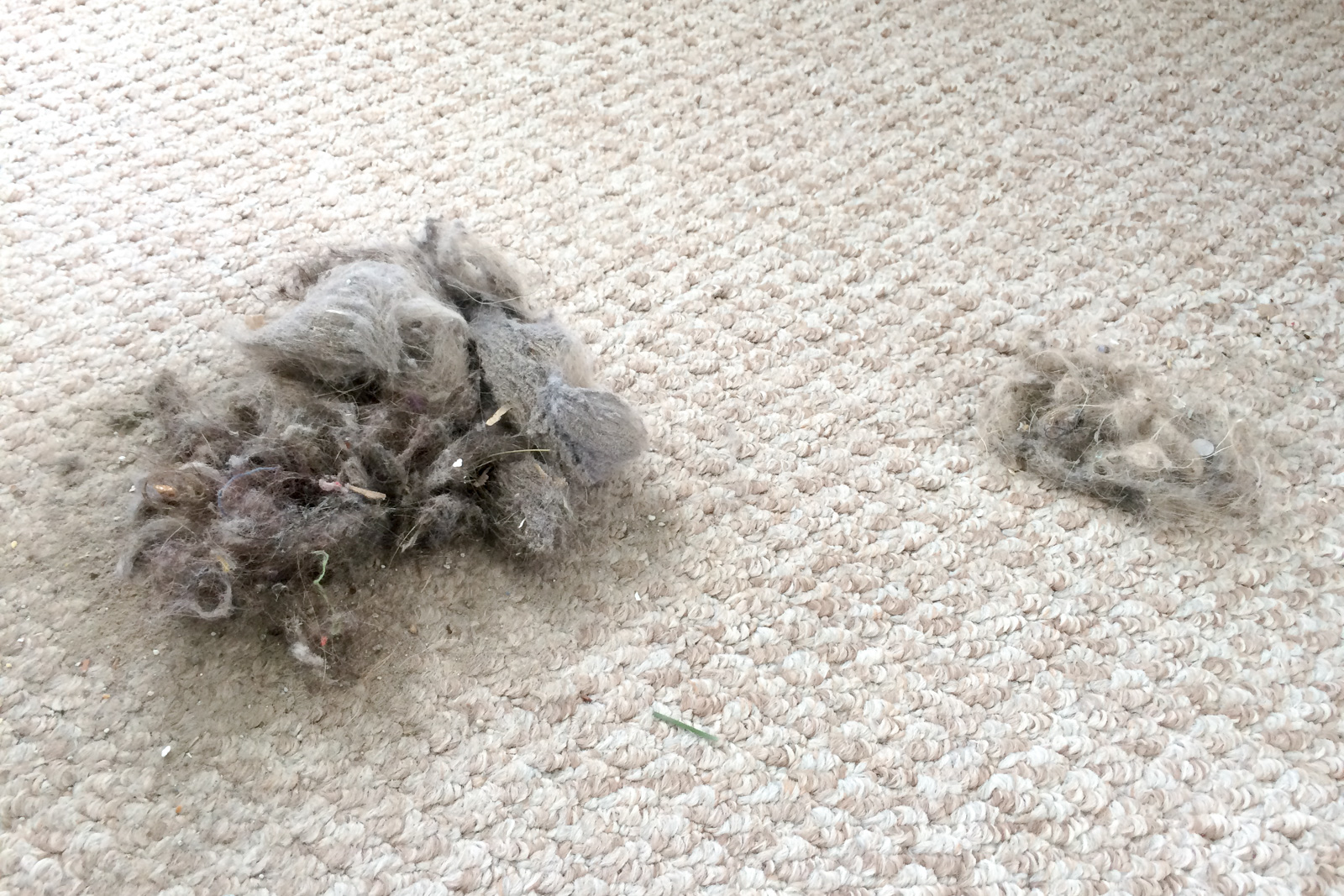
Dyson cordless vacuums are much stronger than most others. The Dyson V6 (an older, similar version of the V7) picked up so much more ground-in debris (left) than the Black+Decker Smartech HSVJ520JMBF27 (right) when we used them side by side. Photo: Liam McCabe The biggest advantage the Dyson V7 has over its competitors is how pleasant it is to use. The handling is light and smooth. At about 5 pounds, it's one of the lightest vacuums available anywhere. The swivel joint at the cleaning head turns as tight as anything we've seen on any vacuum. Because the V7 is so narrow and nimble, it can get into tight spaces much more easily than other models—between or under furniture, for example, or reaching for the ceiling. The dustbin design is one of the best features on the V7. You'll almost never have to get your hands dirty, whereas with most other models you'll have to manually pull out debris from time to time. There's nothing else quite like the Dyson's dustbin. 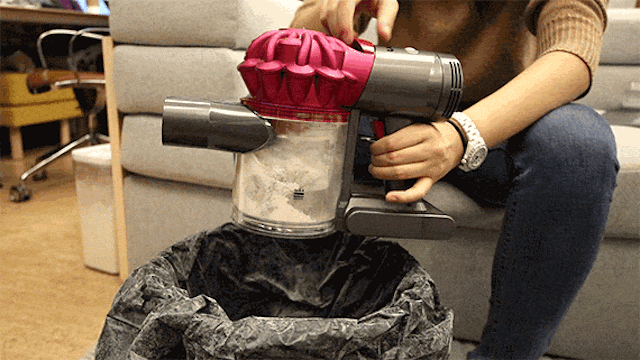
The V7 has a transformer-like trap door for emptying the dustbin, so that you'll almost never have to get your hands dirty. Video: Michael Hession At 70 decibels on regular mode and 74 on Max mode, it's significantly quieter than other vacuums with this level of suction power. It hums along at a lower frequency than most models, too, which tends to be easier on the ears over a cleaning session. For comparison, the Shark IonFlex DuoClean is about five decibels louder on both settings, a very noticeable difference. The V7 is also relatively easy to unclog and untangle because it comes apart in so many places. The cleaning head pops off, the brush roll slides out, a plate comes off the bottom of the head, and the extension tube detaches from the dustbin. This is a pretty common design now, because plenty of other brands aped this design from Dyson. Like most cordless vacuums, the V7 doesn't take up much floor space and can easily fit into a closet between uses. Unlike most models, it comes with a wall-mountable dock, so that you can hang up the vacuum without taking up any floor space at all. The V7 has enough battery life to clean pretty much any apartment in a single pass, and some multi-floor houses, too. We clocked it at about 28 minutes, running constantly, on the standard power setting (or about six minutes on the boosted-power Max setting) with the cleaning head attached. And the trigger-style power switch turns the vacuum off when you loosen your grip, so you'll save juice whenever you pause. That should be enough for about 2,000 square feet if you move relatively quickly. This is all above average for cordless vacuums in general, though some models do have longer run-times. They're either more expensive, or cheaper and weaker. Like other cordless vacuums, the V7 comes with a reusable filter and a belt that should last the lifetime of the machine. You probably will not need to pay for any replacement parts while you own the V7. In terms of customer service, nobody has good data to show that certain brands have faster or more responsive representatives than others. But not many people have mentioned Dyson's customer service at all in Amazon reviews, which is a hint that it's not terrible. A few of our readers have left us comments about poor experiences with them (and we're sorry to hear that!) but the incidence seems low. In our own interactions, Wirecutter staff writer Nick Guy called looking for a solution to poor suction, and the representative walked him through the steps to clear a clog, which fixed the problem. We'd love to keep hearing your stories, good or bad, if you've ever dealt with Dyson's customer service. The V7 Motorhead has a two-year warranty, which is average for the category but less than our runner-up pick. With 4.5 stars out of five based on 222 reviews at the time of writing, customer ratings for the V7 are excellent for a vacuum. Other variants of the Dyson cordless vacs, such as the V6 and V8 series, have great ratings as well, also based on many hundreds of reviews each. Flaws but not dealbreakers The Dyson V7 costs way more than a comparable plug-in vacuum. For some owners, it does not live up to the expectations they had for the price. But this is how much a great cordless vacuum costs. If the price is too steep for your tastes, we don't blame you. Consider getting a plug-in vacuum instead. The most common complaint about cordless vacuums in general is that their batteries run out, and the V7 is no exception. It does not have a removable battery, so you can't extend the run time, and once it's out of juice, you have to wait 3½ hours for it to completely recharge. That being said, 28 minutes should be plenty for most homes. You might find that once you switch to a cordless model, you start vacuuming a few rooms at a time in shorter shifts rather than one long run. Failing that, there are a few models with longer battery lives, like the V8, or you can just get a plug-in model. We also came across several complaints that the V7 runs for less than 10 minutes, or that it can clean only a single room. That's true on the Max power setting, which lasts for about six minutes, but you can turn that off to extend the cleaning time out to 28 minutes. Just toggle the switch on the top of the main assembly. If you're still struggling with short run times even with Max mode turned off, get in touch with customer service. Other V7 owners expected more cleaning power for the price. That's understandable, but this is simply the strongest cordless vacuum you can get without spending a lot more. We've found that on its standard power setting, it cleans about as well as a good $150 plug-in vacuum like the Shark Navigator Lift-Away that we recommend in our guide to plug-in vacuums. In Consumer Reports tests (subscription required), which used the boosted-power Max mode, the V6, a previous model, actually outperformed many plug-in models. Additionally, the V7 Motorhead comes with only two tools: a crevice tool and a combo brush. It does not come with a mini brush roll tool for cleaning upholstery, which is a letdown for the price. However, at the time of writing, Dyson.com is giving away three extra tools of your choosing with the purchase of the V7, including a mini motorized upholstery head. Unrelated to the price expectations, we found a few other common complaints: The V7's quick-release feature means that it won't work with older Dyson tools, like the ones made for the V6 or the older DC44. We do like the quick-release design a lot, because it lets you easily remove tools with one hand—with other vacs like the Shark IonFlex DuoClean, sometimes it takes a lot of jimmying to get the tools on or off. The V7 doesn't really work on high-pile carpets or rugs, because the fibers wrap around the brush roll as it spins. You should not expect the V7 to work on shag, saxony, cable-cut, or other types of rugs or carpets with long, loose fibers. Small, lightweight area rugs often get tangled up in the V7, because the suction is strong and the brush roll is very aggressive. Bigger and heavier rugs, rugs held down by furniture, or rugs with rubber backing should stay in place. The V7 can act like a snowplow—that is, the cleaning head sometimes pushes around large pieces of debris (think cereal) without sucking them up. If you have a toddler who likes to toss Cheerios off the high chair, you can use the V7 without the cleaning head attached (just the open extension tube) to pick up the pieces instead. Alternately, buy one of the Dyson variants with the soft-fiber cleaning head, like the V6 Total Clean. Because the cleaning head doesn't have a locking joint, the V7 can't stand up under its own power. You'll either need to wall-mount the dock (which involves drilling holes) or get used to leaning the vacuum up against a wall or shelf. Driving the V7 can be hard on your wrists. It's a top-heavy vacuum, so you're holding the bulk of the weight in your hands. You also need to squeeze the power trigger constantly while you're vacuuming. As loose as the action on the trigger is, squeezing it is still an effort. (For Liam, Dyson cordless vacuums like the V7 have at times aggravated a lingering case of tendonitis, though he's learned to relax his death-grip on the trigger). People with arthritis pain in their hands or wrists may find the V7 too uncomfortable to use. Our runner-up pick is also pretty top heavy, but has a regular on-off switch that you don't need to squeeze continuously, so that might be a better choice for some people. The V7 can cut out unexpectedly during use, though the problem is uncommon. Although this symptom mean the battery or the wiring is faulty, it usually means the intake is clogged, or the filter is very dirty, or the brush roll is jammed or tangled. When the V7 senses an obstruction like a clog or tangle, it turns itself off to protect the motor from burning out or the belt from popping. So before you panic about the power source, run through your care-and-maintenance checklist to see if you can find a simpler cause. We've heard reports of chronic clogging in the V7, though we really don't know if it's more or less common than with other cordless vacuums. Parts of the intake path are fairly narrow—particularly right at the entrance to the dustbin—so big tufts of thick pet hair may cause blockages. Again, run through the basic steps for care and maintenance to see if that fixes the problem. But if you have pets with long hair, you may be better off buying a great plug-in model like the Shark Navigator Lift-Away, which has wider intakes, a longer warranty period, and a lower upfront cost to offset the risks of chronic problems. Long-term test notes We've tested several Dyson cordless units continuously since early 2014, so we've been able to see how these vacuums hold up over time. We haven't had to do anything out of the ordinary to keep the test units running well—just washing filters, cutting away tangles, and clearing clogs. The units that we've used in homes with pets look pretty grody now, but they still work. Five other Wirecutter staff members also own the V6, an older version of the V7, and they've all been pretty happy with the vacuum for the most part. One of them has had his for three years now, and it's still going strong. A common complaint was long hair getting stuck in the brush head. This happens with all vacuums of all types, and you just need to cut it away with scissors every now and then. The staffers who lived in apartments or one-story houses were satisfied with the battery life, but senior editor Harry Sawyers, said it wasn't enough to cover his whole two-story house. Junior staff writer Alex Arpaia also liked her V6 for "small and contained messes," though she said that "things are significantly cleaner" when she uses her plug-in Kenmore vacuum. Runner-up: Shark IonFlex DuoClean Cordless Ultra-Light 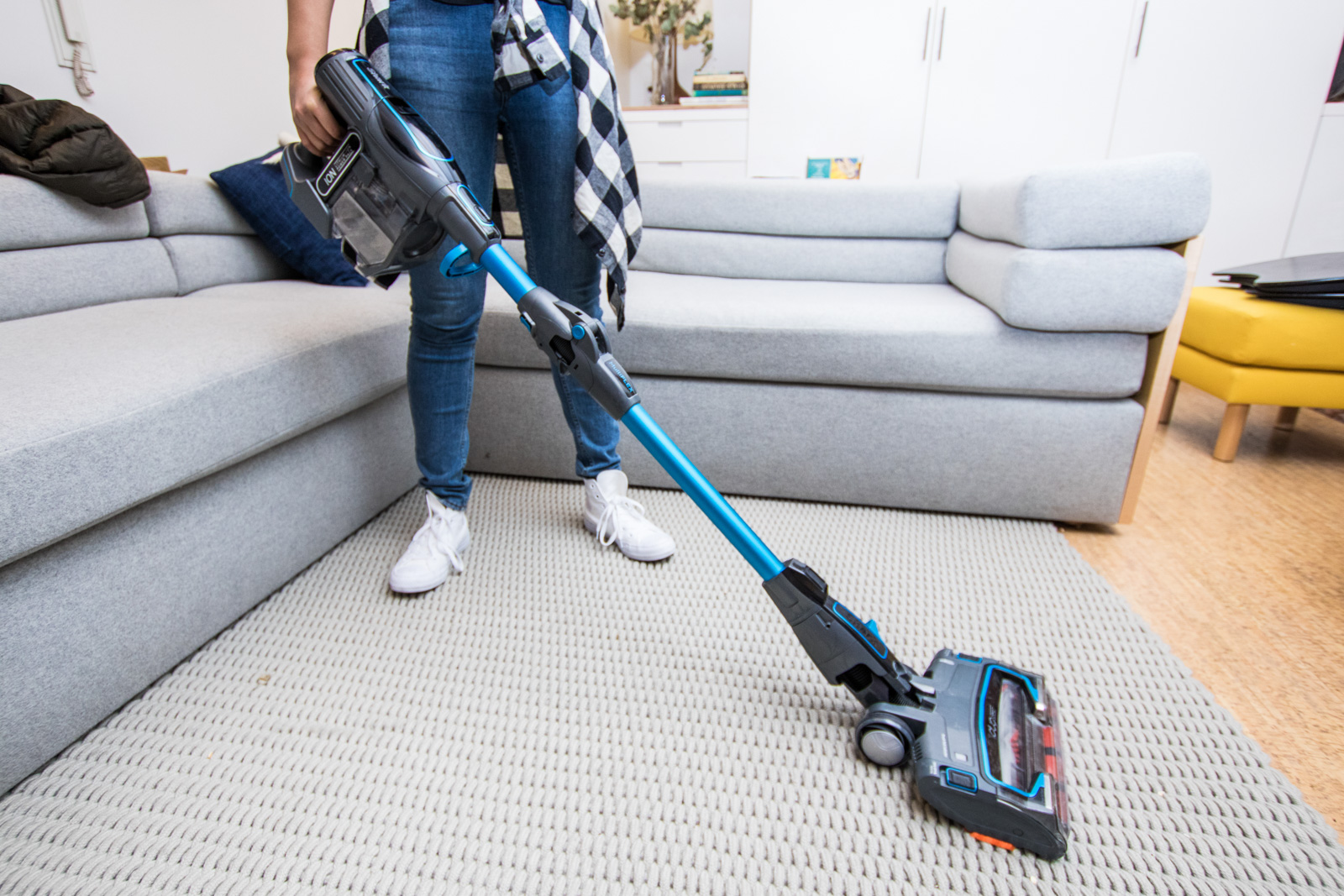
Photo: Michael Hession The Shark IonFlex DuoClean Cordless Ultra-Light is another very good cordless stick vacuum. Throughout our testing, it picked up just as much fine debris from carpets as the Dyson and handled tricky crevices and pet hair with ease. Its dual-brush-roll cleaning head is a little better at cleaning big crumbs off of bare floors, and it has more and better attachments for jobs like cleaning upholstery. On the downside, it's a lot louder and heavier than our main pick, and the battery life is significantly shorter. The most important feature on the IonFlex DuoClean is the cleaning head. It has two counter-rotating brush rolls, which is an uncommon design. A soft-fiber brush roll in the front grabs bigger pieces of debris (like Cheerios) from hard, flat surfaces, preventing them from getting snowplowed. The second brush roll is a regular bristled one for agitating carpet. It's a nice design because the one head can handle pretty much any kind of debris. That being said, we didn't find that having two brush heads improved the carpet-cleaning performance. We didn't rigorously test the bare floor performance, either, so we can't quantify the advantage. The bigger cleaning head also makes the vacuum heavier overall, and we're not sure if it's more likely to break over time (though that part is covered by a five-year warranty). The IonFlex DuoClean also comes with more attachments than the V7 Motorhead, including some useful ones. It has a combined crevice and dusting tool, and most important, a motorized upholstery tool. It also has an "anti-allergen" duster meant for removing fine dust from delicate surfaces. Another convenient feature is that, unlike most cordless vacuums, the IonFlex DuoClean can stand up on its own by folding its joint back. And the IonFlex DuoClean also comes with a five-year warranty on parts, which is very generous as most cordless vacs are covered for only two years. (The battery is warrantied for two years, which is standard.) Shark has good customer service: We've heard consistently, over many years, that its service department readily honors the five-year warranty on our favorite plug-in vacuum. You will not need to bring the vacuum into a shop or ship it to a service center for most claims—they'll just send the replacement parts. It's also one of the relatively few cordless models that uses an external battery pack. Some people prefer this over built-in batteries. When the battery loses its ability to hold a charge (which will probably happen before other parts break), you can swap it out for a new one without replacing the whole vacuum. You can also buy an additional battery pack from Shark to use as a spare, essentially extending the run time to 40 minutes. (Shark also sells the IonFlex 2x DuoClean, the same vacuum but packaged with an extra battery.) 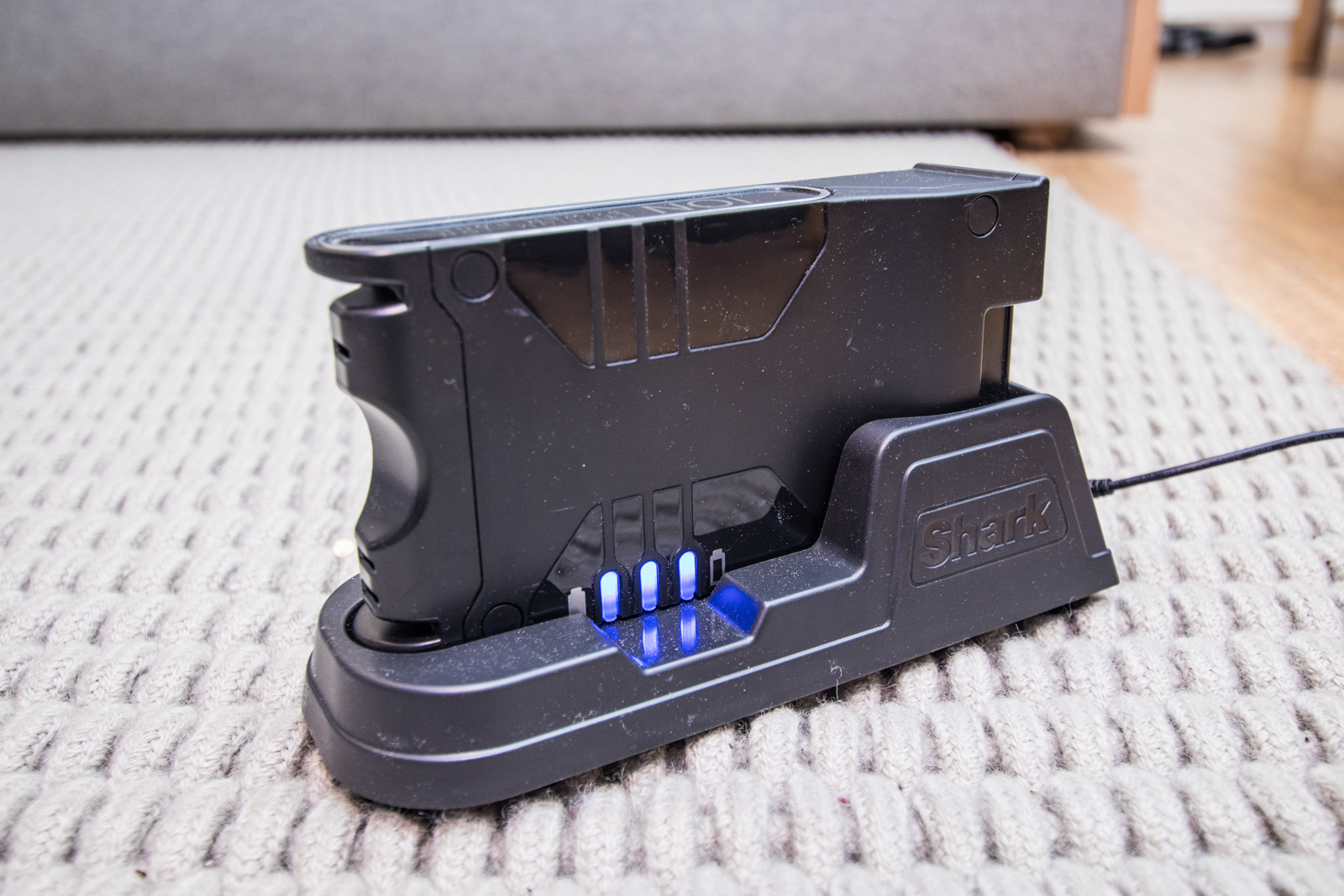
The Shark IonFlex DuoClean runs on a removable battery pack, which charges in a separate dock. Photo: Michael Hession Like most cordless vacuums now, the IonFlex DuoClean has reusable filters and a lifetime belt. It comes apart in a lot of places so it's easy to unclog, too. On the downside, the IonFlex DuoClean just isn't as as easy to use as the Dyson V7. The tools don't attach with a satisfying click. It's harder to empty the dustbin without getting your hands dirty sometimes because it's a standard trapdoor release, much like the older Dyson V6 and most other cordless vacs. Like one Amazon reviewer noted, you'll often have to get your hands dirty if you want to get everything out. At almost 9 pounds, the IonFlex DuoClean was also one of the heaviest and bulkiest vacuums we looked at, which was a complaint of some Amazon reviewers. In our timed slalom test, however, it made its way through the course just as fast as the comparably lighter Dysons, even though it's almost 4 pounds heavier than the V7. We think this has something to do with its cleaning head; the dual brush rolls sort of propel it along the floor, which other owners have noticed as well. 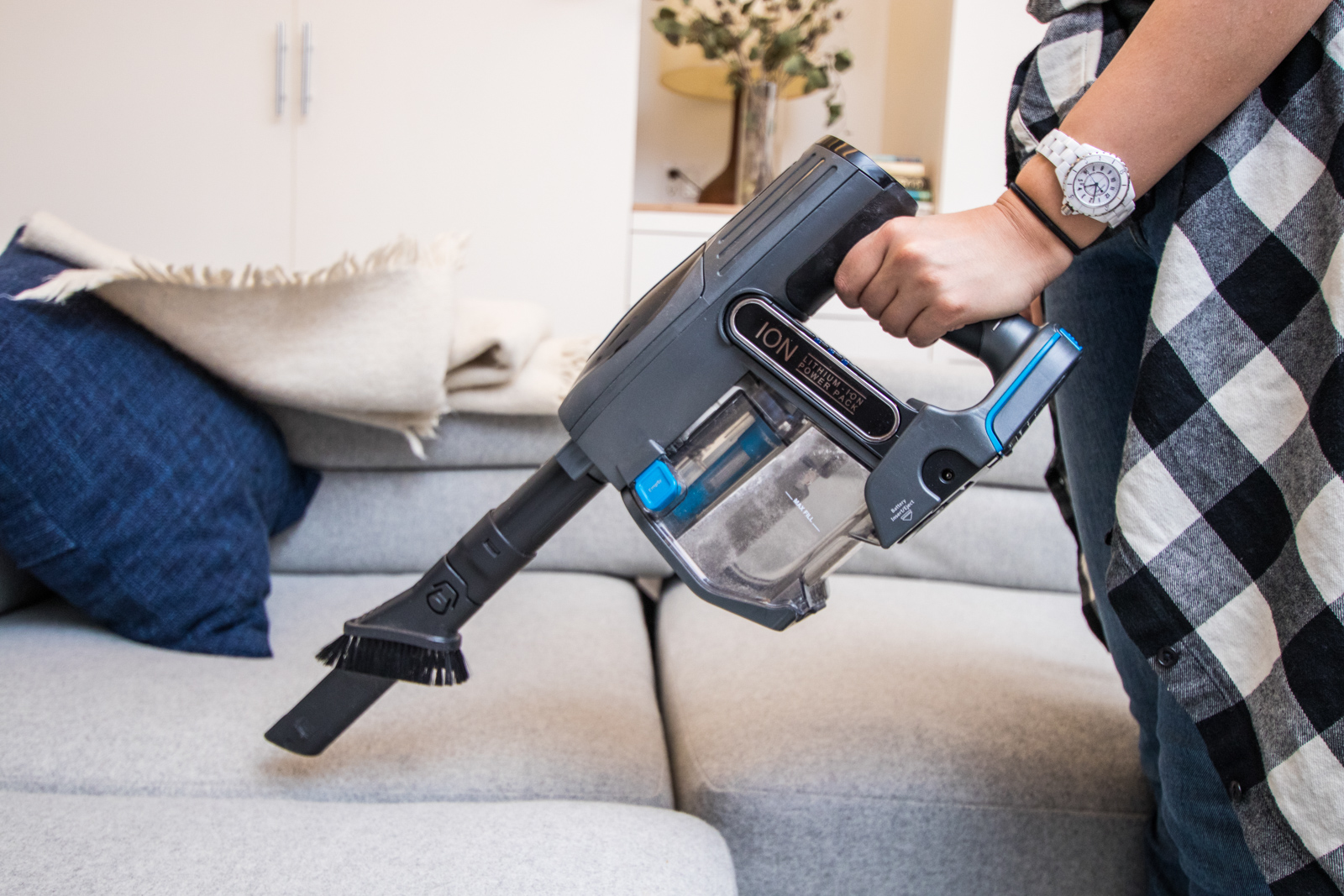
The IonFlex DuoClean also works as a handheld vacuum, pictured here with a two-in-one crevice and duster tool attached. Photo: Michael Hession Noise was another drawback to the IonFlex DuoClean. We measured it at 75 decibels on its extended run mode and 79 on its maximum power mode, which was significantly louder than the other vacuums we tested, including the much-cheaper Dirt Devil Reach Max Multi. At the time of writing, the IonFlex DuoClean doesn't have many owner reviews (it's still pretty new), but they're decent, with an average of 4.3 stars out of five on Amazon. The most common complaint was how the battery didn't last longer than 15 minutes. In our testing, we found that the battery lasted 17 minutes on a full charge, which is about standard for a cordless vacuum. Budget pick: Dirt Devil Reach Max Multi Cordless Stick (BD22522) 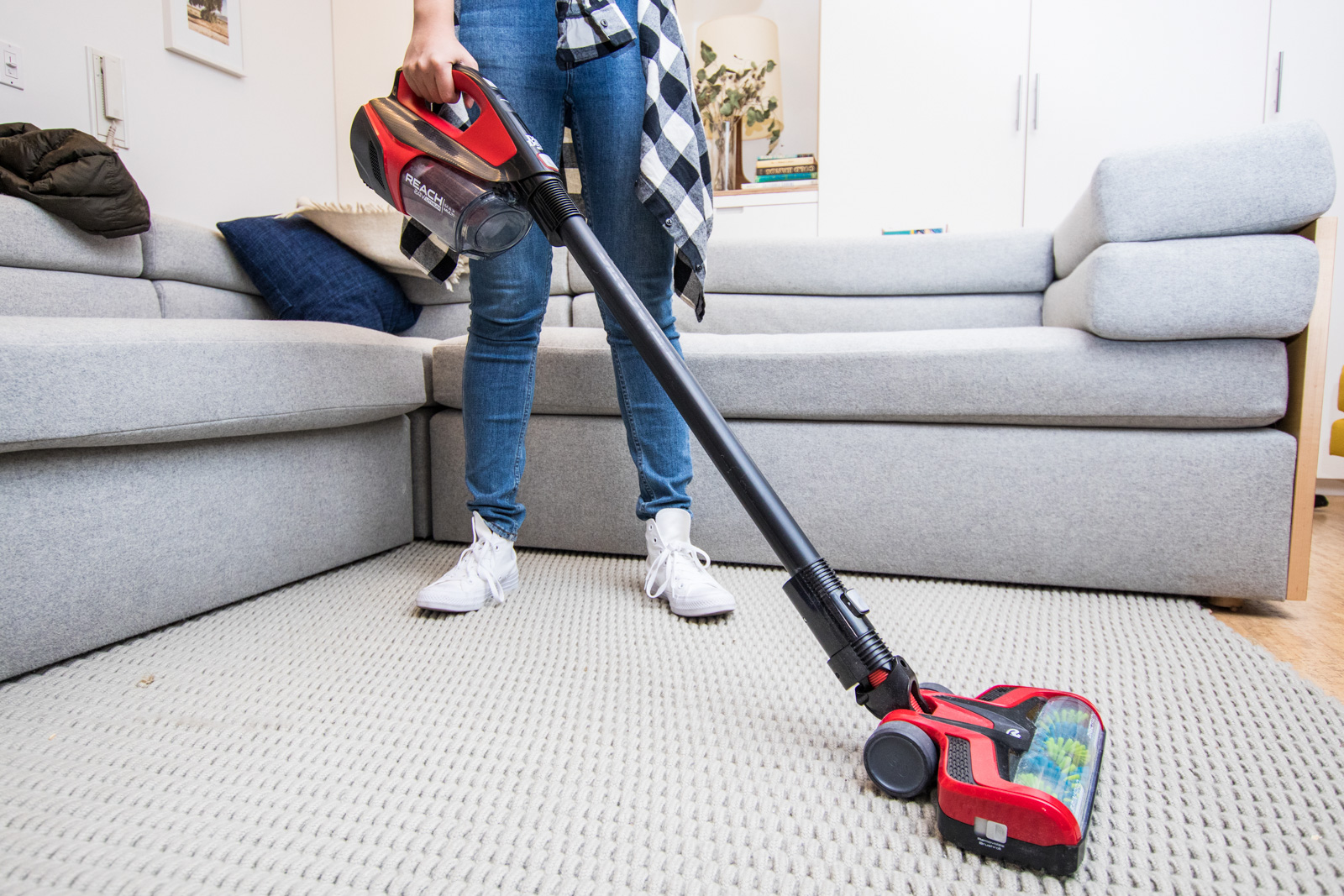
Photo: Michael Hession The Dirt Devil Reach Max Multi Cordless Stick (BD22522) is a great choice if you don't want to spend as much on a cordless vacuum, and you need to clean mostly bare floors. It's the most effective cleaner in this price range, and also comes with better attachments than most, including a tool for cleaning upholstery. That said, it doesn't get nearly as much dust or hair out of carpets as our other picks, so don't expect it to handle the same workload. The Reach Max Multi is a better cleaner than other cordless vacuums at its price. In our tests, it picked up about twice as much flour from a rug as the next best budget vacuum, and grabbed most of the other visible, surface-level debris we threw at it. It's a fine tool for keeping your floors tidy—but not completely clean. If you've only ever used a cheap vacuum anyhow, this vac will seem normal. By comparison, our main pick sucked up twice as much flour, and cleaned up pet hair much faster. Owner-reviewer ShepherdMom wrote on the Target website that this Dirt Devil picks up only about one-third of the fur that her two German Shepherds leave behind. The Reach Max Multi was also the easiest vacuum to handle among our finalists. At 6.4 pounds, it's about a pound heavier than the Dysons. But it breezed through our slalom course in 17 seconds, faster than both Dysons. Its cleaning head swivels smoothly and, though most of its weight is concentrated at your hand, it didn't feel any heavier than the other vacuums we tested. Another nice feature is that the Reach Max Multi has more and better tools than most other cheap cordless vacuums. They're particularly useful when you disconnect the extension wand and use it as a handheld vacuum. The crevice tool fits into a slot in the back of the handheld unit, so you don't have to worry about losing it. It also comes with a motorized stair tool that also works wonders for getting pet hair off of upholstery. Like the cordless Dyson vacuums, the unit doesn't stand up on its own but comes with a support bracket that you can fasten to a wall. 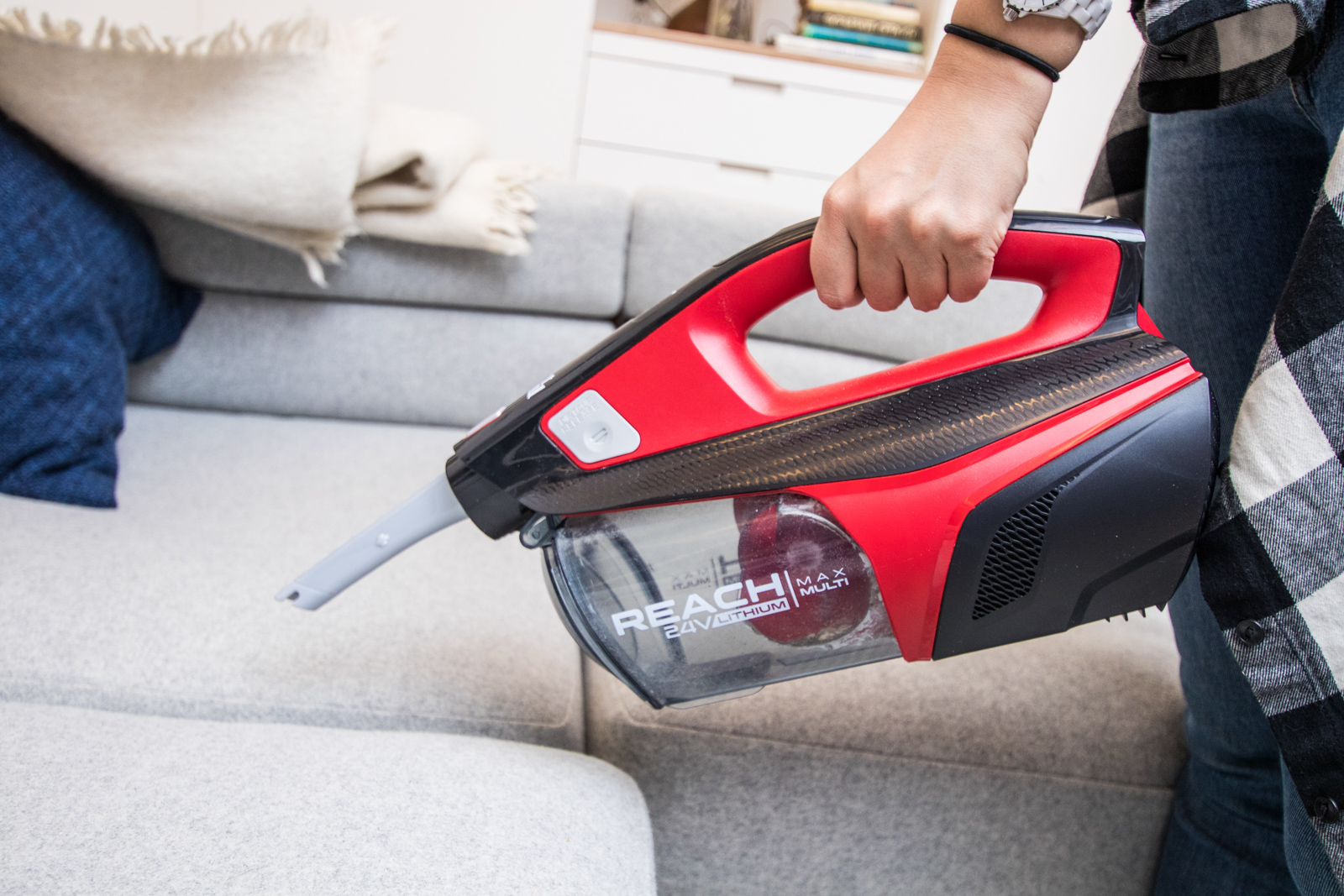
The Dirt Devil Reach Max Multi has the most awkward design for using as a handheld. Photo: Michael Hession In testing, the Reach Max Multi ran for about 22 minutes with the brush roll running, which is actually two minutes more than its advertised battery life. That's enough time to tidy most condos or apartments and typical for cordless vacuums at this price. One thing we're worried about is the owner ratings. At Target, the Reach Max Multi gets decent reviews. But at Amazon, the similar Reach Max Plus (which doesn't include one of the attachments) has a mediocre average rating with quite a few negative reviews that cite poor suction and frequent clogging. However, we think this level of suction strength is better than most cordless vacuums at this price range, so if you approach this vacuum with tempered expectations, we think you'll be happy with it. (Also, feel free to get the Reach Max Plus if the Reach Max Multi is out of stock.) Like any budget model, we don't think the Reach Max Multi will last much longer than three years before the battery or some other moving part wears out. We also noticed complaints about poor customer service with Dirt Devil, so don't expect them to help much if you have a problem under warranty (which is two years). Upgrade pick: Dyson V8 Absolute 
Photo: Michael Hession The Dyson V8 Absolute is the best cordless vacuum overall, but—wow!—is it expensive. It's essentially the same vacuum as the V7, with extra attachments, slightly stronger suction on the Max mode, and a longer battery life. If you have a bigger home, or want to eke out better cleaning performance, you might prefer to upgrade to this model if you're not too concerned about the price. The main advantage of the V8 is its extra battery life. We timed it at slightly more than 34 minutes on the standard power setting, which is about 6 minutes more than the V7. That should let it clean something like 2,400 square feet on a single charge, which is almost the average size of a new house in the US. The boosted-power Max mode, which can pull fine dust out of a carpet like a very good plug-in vacuum, ran for 8 minutes by our measure (it's worth noting that's only two minutes longer than the V7 on Max mode). The V8 Absolute also comes with many more tools than the V7 Motorhead. It has an extra cleaning head, with a soft-fiber brush roll that prevents snowplowing when you're trying to pick up big debris like Cheerios off of bare floors. It also has many more handheld attachments, including a mini motorized tool for cleaning upholstery. 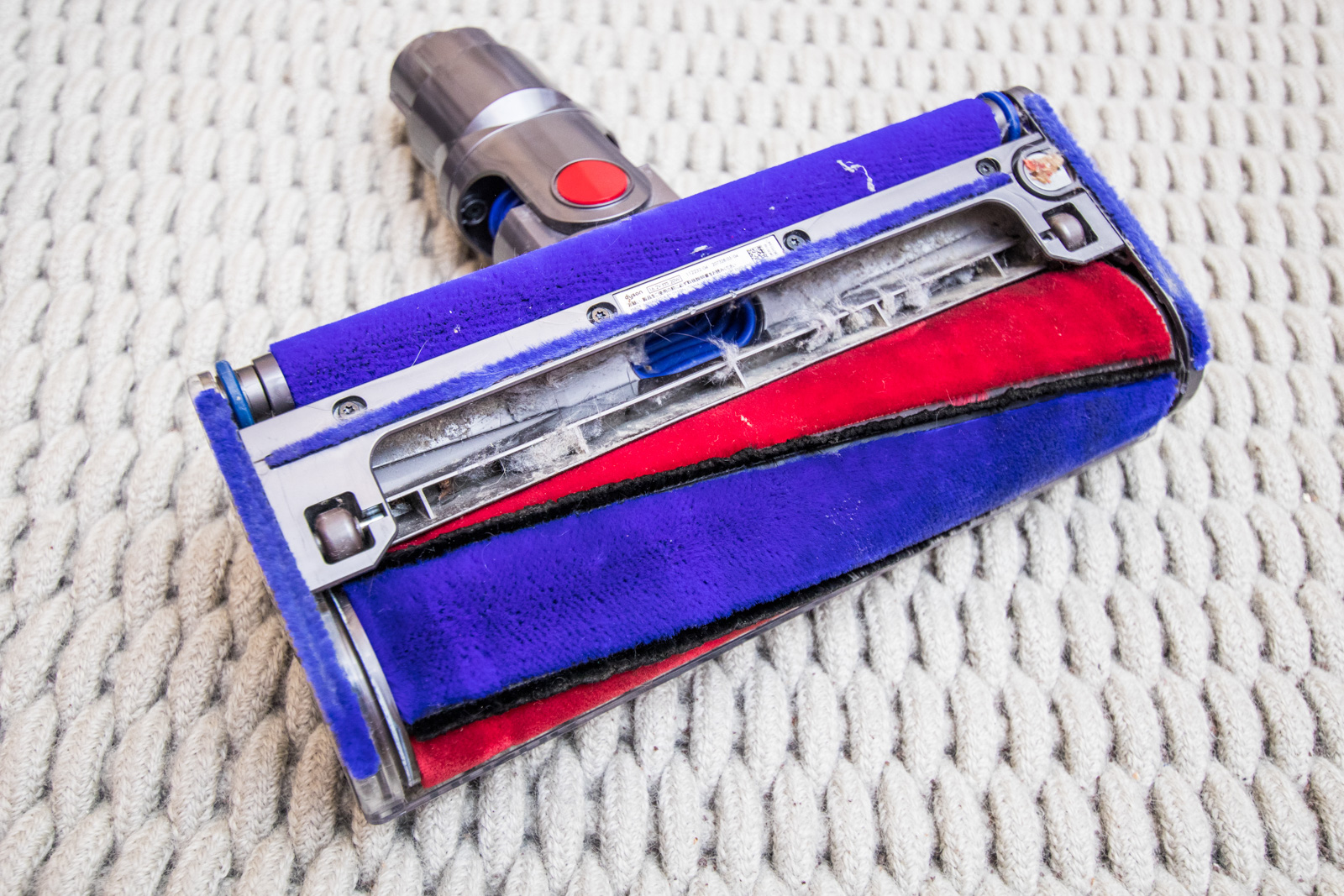
In addition to the regular carpet-cleaning head, the V8 Absolute comes with a soft-fiber cleaning head. It's especially good at picking up big debris (like Cheerios) off of bare floors. Photo: Michael Hession And on the high-powered setting, the V8 has somewhat stronger suction (115 air watts) than the V7 (100 air watts). That should help it pull even more fine dust out of rugs, though in our testing we found that it was negligible difference. Otherwise the V8 is pretty much the same thing as the V7. It has the same great dustbin, same tolerable operating volume, and same easy handling. It's a couple ounces heavier because of the bigger battery, but we couldn't tell while we were using it. Like the V7, squeezing the trigger can get uncomfortable if you deal with chronic wrist pain. 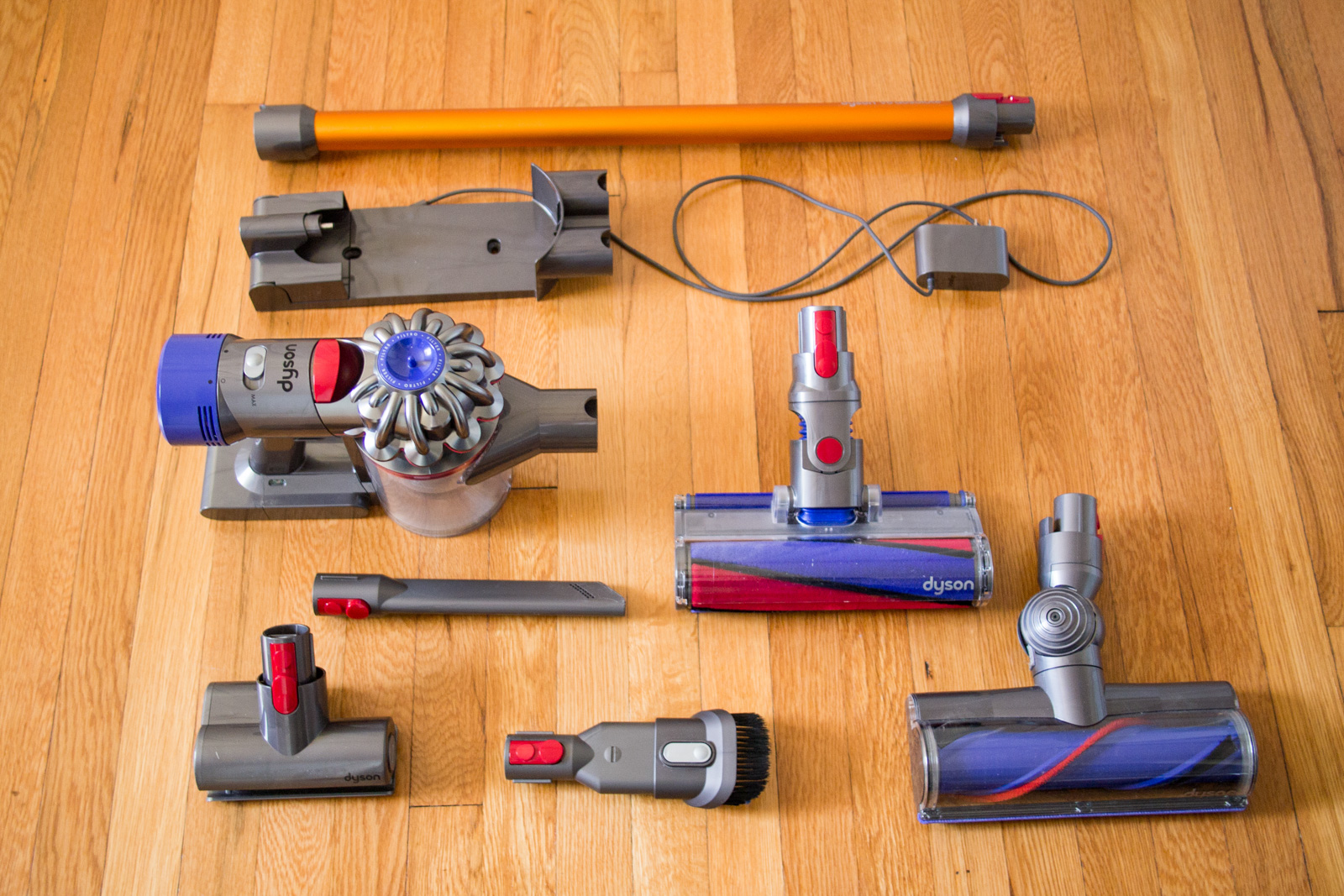
All the accessories that come with the Dyson V8 Absolute, clockwise from the top: extension tube, charger, soft-roller cleaning head for bare floors, direct-drive cleaning head for carpets, combo tool, mini turbo tool, crevice tool, the V8 itself, charging dock. Photo: Liam McCabe That's all great, but the issue here is price. The current everyday street price for the V8 Absolute is about $600, which is a ton of money for a vacuum with a two-year warranty and an expected life span of less than five years. We've seen it for $450 on sale, but that's still wicked expensive. Even the cheaper variant of the V8 is very expensive. The steep price makes this model hard to recommend wholeheartedly, when plug-in models with better filtration, unlimited run times, and decades-long life spans cost the same. The V7 is also almost as good at a significantly lower price. But if you understand the caveats and still think the V8 is right for you, go for it. We've had a great time testing it, and it's a wonderful vacuum. What about the Dyson Cyclone V10? On March 6, Dyson released its newest cordless vacuum, the Cyclone V10. It's the company's new top-of-the-line model, replacing the V8. We got our hands on a V10 Absolute, did some testing, and decided not to recommend it as our upgrade pick. The Cyclone V10 has an advertised runtime of 60 minutes, which sounds impressive but applies only when there aren't any motorized tools attached, on its least powerful suction setting. In our testing, we found that the V10 on this base suction mode sucked up on average 23 percent less debris than the V7 on its comparable setting. Dyson claims that the battery life on that base suction setting is 35 minutes, about 10 minutes longer than that of the older, now-cheaper, and stronger Dyson V8. (Though in one test, we were able to get the V10 to last for 50 minutes). It's quite powerful on its medium suction setting, but then the battery life is only 27 minutes. On its most powerful suction mode, it is by far the strongest cordless vacuum we've ever tested, but we found that it runs for only seven minutes. We think it's fair to say that when it comes to cleaning your floors, the V10 is not strictly better than the old V8. We don't think it's worth the increased cost while the V8 is still available. The V10 costs between $500 and $700 (depending on the accessory set). The V8 is technically discontinued but still available at many retailers for much less than the V10. If you think you need more battery life or accessories than the V7 offers, we say get the V8 while you still can. For more on the V10, check out our blog post. The competition Dyson also sells a V7 Absolute, which has all the tools of the V8 Absolute, with the same battery life and suction as our main pick. A few variants of the V8 are available, too, including the V8 Animal (without the soft-fiber brush roll) and the brand-new, exceptionally expensive V8 Carbon Fiber with even more suction on Max mode. If any of those variants seem appealing to you, go ahead and grab them. We focused on the V7 Motorhead because it seems to us like the most sensible model for most people, and on the V8 Absolute because it's the most fully featured that anyone would need. We debated keeping the Dyson V6 as our main pick (as it had been prior to this update) instead of the V7. But we did a straw poll of the Wirecutter staff, and a huge majority of us said that we'd pay extra to get the V7 instead of the V6 because it's quieter, the dustbin is easier to empty, and the battery lasts about 10 minutes longer. The V7 also has a smoother system for attaching and detaching the cleaning heads and tools. The V6 is still a very good vacuum, and if you want to save a little money and get a similar experience, go for it. You're most likely to get a good deal on the base-model V6 Cord Free, though lots of other variants with different sets of attachments (Motorhead, Animal, Total Clean, Slim, Absolute, HEPA—so many!) are available too. Keep in mind that the street prices for these Dyson variants shift constantly and that you can always buy the attachments separately if you need them. We used to recommend the Eufy HomeVac Duo as a budget option. But it just doesn't stack up against the Dirt Devil Reach Max Multi when it comes to sheer suction power. In our flour test, it picked up less than half an ounce of flour, compared with the Dirt Devil's 2 ounces. We always scour Amazon for the most popular cordless vacuums on the site, which sometimes come from new or relatively unknown brands. One of those that made it into our testing—with good ratings, a cheap price, and long advertised battery life—was the Deik EV660. Even though its battery lasted an impressive one hour and 12 minutes, it picked up the least debris out of all of the vacuums we tested. We also tested the Hoover React BH53200, which is one of just a few cordless models that can sense if it's on bare floor or a carpet and adjust its suction accordingly (some plug-in models have a similar feature). But the cleaning power was just OK, and it was one of the heavier models we tested. In a previous version of this guide, the Hoover Linx was our pick for best budget vacuum. But we decided to nix the Linx this time around because it doesn't convert into a handheld. We just think a two-in-one design is so useful and necessary for couch and other above-floor cleanups. Similarly, the Eufy HomeVac Lightweight is a pretty strong cleaner, but it can't convert into a handheld vacuum. The Hoover Air Cordless Lift has more battery life than even the Dyson V8, and costs a lot less, with a longer warranty. But it is not a great cleaner, doing poorly in our tests and Consumer Reports's too. The Hoover Cruise is a Dyson V6 knockoff in looks but not in performance—it's a weak cleaner, and isn't that cheap, either. It does have one neat feature we'd like to see Dyson adopt: a toggle-able lock for the trigger switch, so that you don't need to keep squeezing it throughout the cleaning session. The Hoover Air Cordless 2-in-1 used to be our top pick several years ago. But it's a budget option by today's standards, and not a particularly good one anymore, with a short battery life and many documented cases of battery defects. The Black+Decker Smartech HSVJ520JMBF27 looks like it can compete with the V6 on paper, but the cleaning power was pitiful in our tests. The Bissell AirRam is highly rated by Consumer Reports. But when we tested it, it did not perform well on either bare floors or carpets. It doesn't convert to a handheld vacuum, either. We considered testing the Bissell Multi. But we tested the handheld version in 2016 and were underwhelmed by its cleaning performance. It's a popular model, but it just doesn't cut it in terms of suction. Tons of other cheap cordless vacuums are available from the likes of Bissell, Black+Decker, Electrolux, Samsung, Hoover, and others. We have not tested all of them, but based on our research we believe that our budget picks in this guide are better choices than any of those. The Tacony Corporation makes a couple of expensive cordless vacuums, but we don't think any of them are great. The Simplicity Cordless Freedom, for example, has a powerful battery and the longest battery life we've seen in any cordless model. It's even more expensive than the Dyson V8 Absolute. But when we tested a plug-in version of this vacuum a few years ago, it was not a particular great carpet cleaner, and it doesn't convert into a handheld cleaner. The Riccar Roam Cordless Broom Vacuum has a strong, long-lasting battery and a hose for above-floor cleaning, but it's still very pricey, and doesn't look as easy to use as similarly priced Dyson models. We considered testing some of the popular Dyson knockoffs available on Amazon, because they are much cheaper and advertise many of the same features, including the Proscenic P8 Stick Vacuum and Dibea C17. But we've tested similar knockoffs in the past, and their suction and quality have been much weaker. Both Amazon pages also have poor grades on Fakespot, so we ultimately did not test them. We may reconsider in the future if they become more popular. What to look forward to We've been hoping that the LG H7 would arrive in the US this year. We first saw it at Consumer Electronics Show (CES) in 2017, and it looked like a convincing Dyson V6 knockoff. It's supposedly stronger than Dyson models, able to move 140 air watts (up from 100). LG told us in September 2017 that the company is actively working on getting this model out, but that it's had to design from scratch a wall-mountable dock and redesign the brush roll to get it to work on the thicker, softer carpets that we tend to have in America. (In Korea, where the vacuum was designed, most people live in concrete buildings, so wall-mounting is not a popular option, and carpets are much less common.) At the time of writing, LG still has not announced pricing or availability for the H7. This guide may have been updated by Wirecutter. To see the current recommendation, please go here. Note from Wirecutter: When readers choose to buy our independently chosen editorial picks, we may earn affiliate commissions that support our work.
via Engadget RSS Feed https://ift.tt/2HzXPwY |
It is what I was searching for is really informative. carpet cleaning Aylesbury It is a significant and useful article for us. Thankful to you for sharing an article like this.
ReplyDeleteThe information you've provided is useful because it provides a wealth of knowledge that will be highly beneficial to me. Thank you for sharing about vancouver snow removal. Keep up the good work.
ReplyDeleteYou have provided valuable data for us. It is great and informative for everyone. Keep posting always about Carpet Repairs Adelaide. I am very thankful to you.
ReplyDeleteYour blog contains lots of valuable data. It is a factual and beneficial article for us.Buy Windsor Vacuum Cleaner Parts Thankful to you for sharing an article like this.
ReplyDeleteI found decent information in your article.bedroom rugs I am impressed with how nicely you described this subject, It is a gainful article for us. Thanks for share it.
ReplyDeleteI really appreciate your work which you have shared here about The article you have shared here is very informative and the points you have mentioned are very helpful. Thank you so much.Spot Free Water System
ReplyDelete